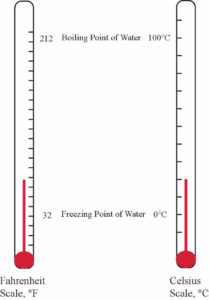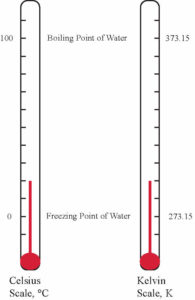Most of us are familiar with two temperature scales, the Fahrenheit scale, oF and the Celsius scale, oC. To convert from oF to oC , we must know that the intervals of degree on the two scales are quite different. Each unit on the Celsius scale is nearly twice each degree on the Fahrenheit scale:
1oC = 9/5 oF = 1.8 oF
A temperature increase of 10 degrees on the Celsius thermometer would equal a temperature change of 18 degrees on the Fahrenheit scale. To convert temperature readings between the two scales, we must not only factor into the calculation the size difference of the degrees, but also the temperature difference for the freezing point of water on both scales, 32oF verses 0oC.

When converting from Fahrenheit to Celsius, the 32 degree difference is subtracted, and converting from Celsius to Fahrenheit, the 32 degree difference is added. To convert from degrees Celsius to degrees Fahrenheit use the following:\(\mathbf{^o{F}\;=\;1.8\;^oC\;+\;32}\)To convert degrees Fahrenheit to degrees Celsius:\(\mathbf{^oC\;=\;\frac{^oF\;-\;32}{1.8}}\)
There is a third temperature scale, the Kelvin scale, K. The Kelvin temperature scale is also referred to as an absolute temperature scale–the lowest temperature is 0 K which is equivalent to -273.15oC. In chemistry, both Celsius and Kelvin scales are used. In laboratories, temperatures are measured using Celsius thermometers. For some calculations, the Celsius measurements are converted to Kelvin. The SI unit for temperature is the kelvin. In comparing the intervals on the Celsius scale to the Kelvin scale, we find the unit sizes are the same, and this greatly simplifies interconverting between the two scales. A comparison between the Celsius and Kelvin scales is shown in the following figure.

In the figure, both the freezing point and boiling points of water are indicated. On the Celsius scale the freezing and boiling points are 0 oC and 100 oC respectively. On the Kelvin scale, the same points are 273 K and 373 K. From this we can see that for both temperature scales, the difference between the freezing point and boiling point is 100. This demonstrates that the size of the intervals on both temperature scales are the same. So to convert from Celsius to Kelvin, add 273.15 to the Celsius temperature,
and to convert from Kelvin to Celsius, subtract 273.15 from the Kelvin temperature.
Note that the degree symbol is not used with Kelvin temperatures.
Videos for Temperature
Formulas for Temperature Conversions
Exercises for Temperature
1. To calculate the volume of a gas, the temperature must be in Kelvin units. The temperature of a gas was measured at 74.6oC. What is this temperature in Kelvin?
Check Answer and/or View Worked Out Solution
2. A student measures the temperature of a solution using a Fahrenheit thermometer. She records a temperature of 116oF. What is this temperature on the Kelvin scale?
Check Answer and/or View Worked Out Solution
3. The temperature of a gas was measured as 234 K. What is this temperature in oC and oF?
Check Answer and/or View Worked Out Solution
Back to Study Guide List for General Chemistry 1
Go To Home Page
